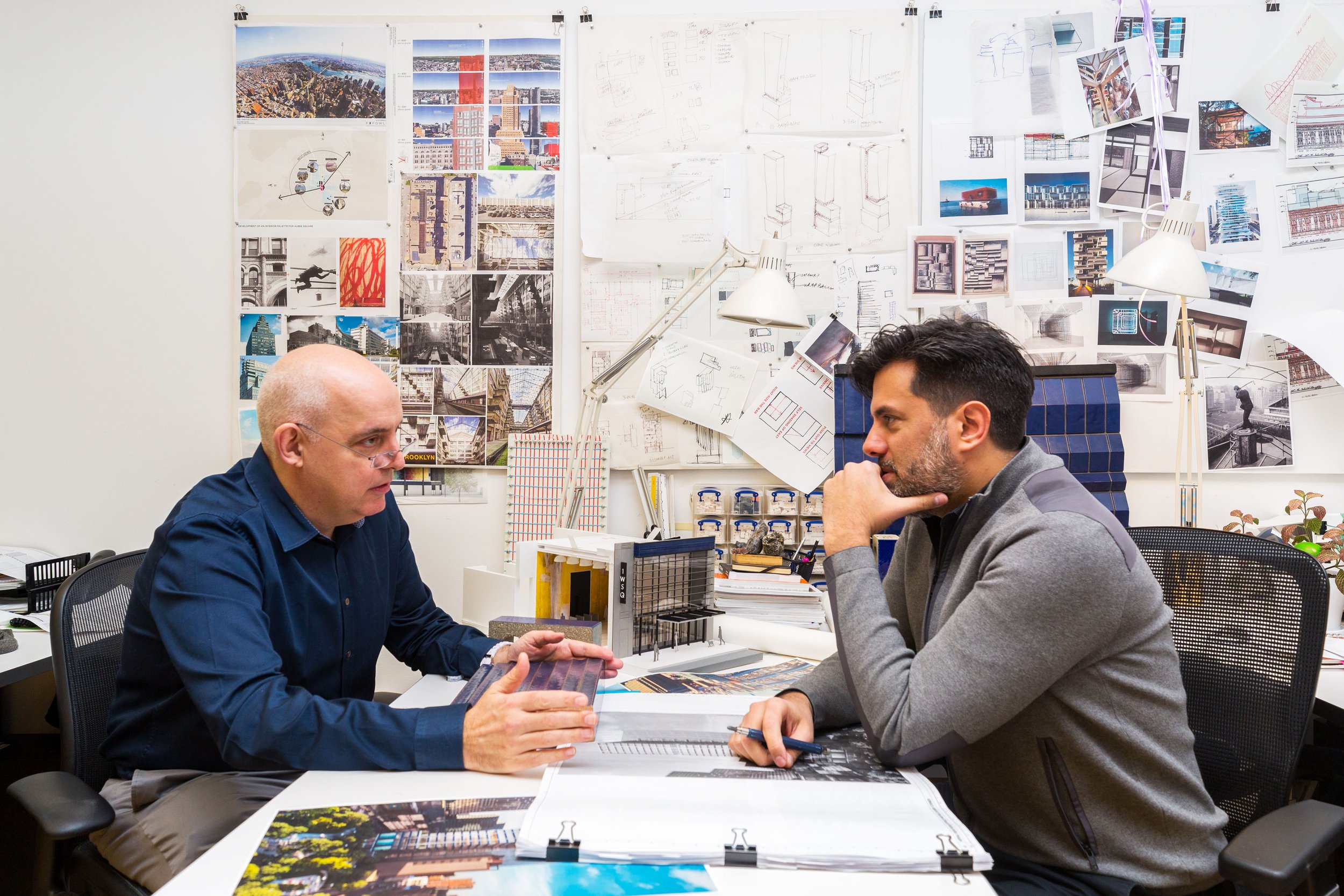Get to Know Dan
October 26, 2022 | Interview by Emilia Charno
Dan and FXCollaborative Partner Gustavo Rodriguez discuss design of 1WSQ
Dan and Cornell Classmates in Rome, Italy
As a senior partner at FXCollaborative, Dan serves in a design and leadership capacity for many complex, award-winning urban buildings. Adept at creating large-scale, high-performance buildings and urban designs, Dan approaches each project—from individual buildings to large-scale urban plans—with the viewpoint that it must contribute to a larger totality. Dan plays an instrumental role in a variety of projects spanning office, residential, mixed-use, and urban design. He has been recognized both nationally and internationally for his design excellence over the years by numerous organizations and publications, including the American Institute of Architects, Architectural Review, and the Boston Society of Architects. Dan is a Fellow of the American Institute of Architects.
To start, can you share a bit about the journey that got you to where you are today professionally?
My father was a psychoanalyst and my mother was an interior designer - a good background for being an architect! Growing up, my mother ran a thriving practice out of our home, and I - like many architects - gravitated towards design at a young age. I later went to Cornell University to study architecture and truly found my calling. After studying, I worked and studied in Europe in the mid-1980s – a time where there was lots of dialogue about reinvention and reconsideration of the “City.” I returned to New York and worked for a small firm run by a husband and wife duo for three years. My first big project was a Park Avenue residence for a young fashion designer named Vera Wang. We worked and re-worked every square millimeter of that apartment. This was phenomenal training, and I was able to see how, even on smaller scales, design is made up of a myriad of interrelated pieces and decisions.
I had known Bob Fox and Bruce Fowle - the firm’s original founders - since I was in high school. When I began to work here, the firm was called Fox & Fowle Architects. My first day was on the same day as the 1987 stock market crash, and since then I have seen the firm change and evolve at least half a dozen times. It has been a fascinating ride and we have evolved into the firm we are today: a design-first firm focused on sustainable city-building. We have interest and expertise in every component of this, including master planning, transportation, high rise development, mixed-use development, residential, interiors, among others. Now as Senior Partner, I set general design and strategic direction. I like to describe my role as 90% coach, making sure the table is set for doing great work, and 10% goalie, stepping in to make the occasional save.
What other disciplines inform your thinking and your work?
I am a student of history and architectural history, and I believe you can only understand where you're going if you understand where you are, and you can only understand where you are if you understand where you’ve been. Having attended Cornell in the early 80’s, it is in my DNA to marry contemporary city-building with historical memory. This sentiment inspired me to work and study abroad in Europe. At that time, there was ferment in the rediscovery of the full spectrum of the history of architecture and urbanism - or at least western architecture and urbanism. There was an interest in models where modernist architectural thought and more traditional concepts of urbanism existed more seamlessly, an area that still motivates me.
What are the values that drive your work?
In our work, we seek a balance of three things: context, performance, and innovation. Context is the urban and landscape history of a physical place, including consideration of cultural and climatic dynamics. Performance is in the thoughtfulness and execution behind a physical design and structure. In our craft, there is working and reworking to ensure a building is enduring. This component includes our rigorous environmental performance standards. Innovation embodies intuition, magic and emotion - the intangible part of design, the moments that move you.
Kyanite Partners shares a home with FXCollaborative at 1 Willoughby Square. What can you tell us about the building?
1 Willoughby Square is the personification of our values. With consideration to context and performance, it is the reinvention of the Brooklyn industrial loft. From a performance point of view, this building was awarded the highest-rated LEED platinum interiors in the country. It is a platform for collaboration. Winston Churchill said, “We make our buildings and they make us.” To live in your own work is every architect’s dream…and nightmare! It’s one thing to draw, model, and watch a building evolve - it is a whole different experience to live or work in your own design.
What does your creative process look like when starting a new project or building?
Collaborative is in our firm’s name. Collaboration is a promise we make to clients, allied professionals, the public, as well as to ourselves. Instead of responding to the impulse of rushing to solve a problem, I focus my initial energies setting goals, tone, and ethos. My role is to ask in clearest terms “What does this building want to be?” and “What does it want to accomplish?” Once the problem is defined, my next step is to unleash the ingenuity and creativity of our team.
What do you see as the 2-3 most critical strategies for NYC to promote equity and accessibility in its urban design and architecture?
Firstly, we need to reinvent the Central Business District (CBD) - e.g., Midtown Manhattan, Downtown Manhattan, and Downtown Brooklyn. Take a moment and think of Midtown Manhattan. There is no place to convene and to simply be . What makes a city inclusive is really its public realm. In an income- or race-segregated suburb, you often only encounter people like you. In a city, one with a robust public realm, you can see and feel yourself part of a much larger whole. It is my strong suspicion that people feel more invited to step into civic conversation in this environment. We need to look at projects that increase these opportunities to enhance the public realm, to make streets and spaces less car-focused and more people-focused, greener, and inclusive.
Next, I am a great believer in inclusionary housing. Being New Yorkers, we like to fight over the details, but it's worth remembering that New York is at the cutting-edge of the inclusionary approach - far ahead of other North American cities. We should be incentivizing the private sector to build as much mixed-income housing at every scale: small, medium and large . New York is a giant mixing bowl of people - it's what makes it great. Working against a monoculture of income in housing should be a top priority.
Lastly, we must reexamine the impact of landmarking on the health of neighborhoods and the city as a whole. In New York we understandably have a deep love of our historic buildings and neighborhoods. As a result, we have an activist preservation community and a rigorous landmarks regime . In some ways, the movement is a victim of its own success, with a significant percentage of the city under the purview of the Landmarks Preservation Commission.
It is well-documented that the combination of disinvestment post-WWII, coupled with redlining, systematically drove down the values of historic neighborhoods. Folks then bought properties at low prices, the process of gentrification began and then growth was capped by landmarking . We see values driven up and density go down as landmarked neighborhoods have grown wealthier. These neighborhoods are well served by civic infrastructure - schools, transit, institutions - precisely where growth should occur. Though politically fraught, there needs to be an intelligent reset and rebalancing of our approach to landmarks.
What is a place that has deeply shaped you?
Cornell University has deeply shaped me. I spent a summer at Cornell while in high school, attended five years of school there, and have served on the advisory board for over twenty years. The school of Architecture, Art, and Planning and its community have both impacted and sustained me as a professional.
Is there anything that you’re reading or watching that’s inspiring you?
I’ve been reading several books by the brilliant essayist Rebecca Solnit. Her book on Orwell, Orwell’s Roses, is about the importance of aesthetics and pleasure as a key part of social critique told through the lens of gardening. A Paradise Built in Hell is about the spontaneous spirit of mutual aid that people instinctively and consistently give in the immediate aftermath of disasters. It is an exploration of altruism by the many and the more jaundiced view of mutual aid typically held by elites. Given the challenges we will increasingly face with the climate crisis, this is a thought provoking read.
I am a student of history and architectural history, and I believe you can only understand where you're going if you understand where you are, and you can only understand where you are if you understand where you’ve been.
Dan speaking at the 1WSQ topping off
Cornell classmates 35 years later in Rome, Italy




